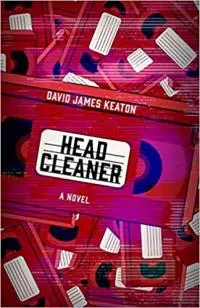So, there’s this long and rich history of ridiculously lucky fictional villains and their impossibly successful schemes. Think Heath Ledger’s Joker from 2008’s The Dark Knight, with a master plan where he wants to get caught so that some dude who swallowed a bomb or maybe a phone (who was somehow not the guy from The Tao of Steve, sorry everybody who I convinced it was) so it will blow up when the Joker makes his one phone call so he can be unleashed yet again to go on a diabolical series of very Two-Face-like schemes (constantly setting up double bombs to make people have to choose? Check your branding, bro) and where he somehow anticipates every choice anyone will make along the way. The point is, much like many of the most intricately orchestrated plans in fiction, none of this makes much sense in reverse. So writing it backwards to begin with has got to be the most effective way to craft a narrative like this, right? Consider the popular new film Glass Onion, which is a frustrating example of both backwards plotting and withholding information. But the simple fact is, in The Dark Knight, any minor deviation by an unknowing cast of characters would have resulted in Heath Ledger waiting around forever with only his bounce house of burning cash to console him.
Or consider Professor Moriarty, dubbed by Sherlock Holmes in the 1893 (!) short story “The Final Problem,” the Napoleon of Crime, a nickname not nearly as funny as “the Genghis Khan of World Finance” who goes up against Monk in his series finale. This short story was Professor Moriarty’s first, last, and only real appearance as written by Sir Arthur Conan Doyle (I’m not going to verify this claim with actual research, but does anybody *really* count “Valley of Fear,” written much later for no good reason?). So the “Final Problem” seems to be a sort of Death Ex Machina, conjured up by Doyle to finally kill off his hero and rid himself of the obligation of writing those stories forever. Now, Moriarty probably got waaaaay more diabolical after that character’s copyright ran out and he was able to run amok on TV and film, but here in his only* short story, he doesn’t seem to plan a whole lot of anything, except to murder Sherlock Holmes. So in this story, there’s a hat trick of attempts on Holmes’ life, with Moriarty simply chasing him all over to set up a final brawl on a waterfall for them both to plunge to their apparent deaths. And if there was a master plan in any of that, I must have missed it! And Doyle mostly tells instead of shows Moriarty’s genius here, but even with that shortcut he still sounds relatively passive as far as criminal masterminds go: “Motionless like a spider, but his web has a thousand radiations…” So mostly his scheming involved organizing mundane shit but not getting caught. Oh, and he was also really good at math? Booooo.
 Of course, Hannibal Lecter will almost always come up in any conversations about super-duper villains, and there probably is something to that, as he’s a man so crafty he gets every film adaptation to spell his name differently.
Of course, Hannibal Lecter will almost always come up in any conversations about super-duper villains, and there probably is something to that, as he’s a man so crafty he gets every film adaptation to spell his name differently.
But they are all nothing compared to the luckiest serial killer on earth, who was recently declared (according to a recent disreputable poll that flashed past me on the waterfall of the internet) the “Most Smartest Villain of All Time Ever.” Yes, we’re talking about John Doe from Se7en. And, yes, I mean “Se7en,” which would be pronounced “Suhsevinin”. Turns out, when tasked to list the most nefarious geniuses on screen or on the page, nobody on the internet could come up with a proper “literary” villain, just one from the movies. However, if we were being as forgiving as this particular website in allowing my article to snuggle in here with their other “writing-based” content, the seven deadly sins were totally in a real live book once (the novelization of Se7en by Alan Dean Foster).
But maybe there’s a good reason for these poll results. Perhaps it is harder to get away with insanely complicated schemes on celluloid than it is on wood pulp, which will result in literary supervillains who are forced to be a little more realistic and, by proxy, more empathetic? Only on the big screen can you serve up all that visual razzle dazzle to trick the viewer into thinking that these schemes really do move forward, when essentially it’s just the strangely satisfying collateral damage of a screenwriter plotting backwards.
[This is where a more desperate writer would insert references to an upcoming work, and I’m not going to do that, despite my new novel Head Cleaner containing a previously unseen, er, unread, masterplan involving convincing someone they’re embroiled in a time-travel scenario when they’re not. Or are they? Sounds impossible, right? The level of manipulation you’d have to apply to the mark’s surroundings to convince them that time travel was happening seems out of reach, but it’s easier than you think. You know why? Because I totally wrote it sideways (see above). Speaking of…]
So let’s go back to John Doe in Se7en (who was portrayed by some tinseltown pariah and uncredited in the film, as well as being uncredited here. See that shit? That’s called integrity!). John Doe has a fussed-over-for-a-lifetime, insanely meticulous plan of action, which he declares to our heroes “will be puzzled over for years to come.” But this plot, like most plots, is as precarious as an actor’s unmolested reputation. But he was right, it turns out, and John Doe’s plan has been puzzled over for years, but probably not for the reasons the writer hoped. And this is Andrew Kevin Walker we’re talking about here, uncredited script doctor for Event Horizon, which means he was likely responsible for all the rhyming dialogue in that film’s opening sequence ("Someone drops the ball we get the call!" "Locked and cocked and ready to rock!" "Everything's green on my screen!" Can a movie win a Pulitzer?). But think about it. If you’ve seen Se7en, I mean. If you haven’t, go check it out and I’ll wait. Depending on your choice of medium, it may or may not have that Fast and the Furious number in the title. Okay, so as you probably noticed, without somehow predicting the exact actions (and more importantly the exact reactions) of all seven (eight?) of his victims, as well as David Fincher’s particular brand of ice-cold but no less spectacular razzle dazzle, John Doe’s masterplan would have almost certainly failed at every turn. And to prove this, with the help of MIT probably (which is where they house the WHOPPR computer in WarGames), I was able to instantaneously run through millions of hypothetic scenarios for John Doe’s “forced attritions” (picture Dr. Strange doing that skeevy Jacob’s Ladder head tweak) and, unsurprisingly to me anyway (the computer, however, did shit itself) every single result was the same! Utter failure. Now, I’m aware of the current A.I. controversy, but below are our results of this experiment just the same. And here’s how it would actually play out, sin by sin by sin.
GLUTTONY
It’s clear from the reveal of his cupboard contents that John Doe’s first victim is not simply a lover of spaghetti sauce, but in fact a competitive eater. Not only does John Doe make a crucial error in choosing a victim who is essentially immune to his choice of torture, it’s kinda like “My Dinner With Vizzini” in The Princess Bride here, but instead imagine giving Vizzini canned spaghetti and he goes, “I’ve spent the last ten years building up an immunity to Chef-Boyardee!” Ironically, this outcome is the closest to what was depicted in this fanciful film because, despite cupboard upon cupboard full of spaghetti, John Doe makes a trip to the grocery store in the middle of his torture, presumably to try a different brand? One that this guy doesn’t love so much? Who knows. And then, as is revealed in the autopsy, John Doe resorts to kicking the guy to death, which no one acknowledges as the meatball on top of the utter failure that is his short-sighted lesson on indulgence.
GREED
Eli Gould is told to provide a pound of flesh, “no more no less.” Supposedly, this offering is to come from his own body. However, as defined by Mirriam-Webster’s Collegiate Dictionary, “flesh” is just another name for the same sort of high-end steak Gould certainly enjoyed for dinner that same evening. So to foil John Doe yet again, Gould simply turns the knife around and sticks the handle down his throat, vomiting all over the scale. Whether it’s precisely one pound of half-digested steak isn’t for us to decide. I mean, John Doe would have better luck weighing a man’s soul, am I right (exactly 8 pounds. Or is that a human head). Either way, this is coincidentally the preferred weight of a steak provided by any Michelin star restaurant frequented by rich lawyers. Dejected, and now zero for two, John Doe stabs Gould in his now-empty stomach.
SLOTH
 Incredibly, John Doe keeps this guy alive for years, paying the rent on his gargantuan apartment and stapling little green rearview mirror trees to the ceiling to keep any landlord from sniffing around. But what he doesn’t count on are the ridiculous rent increases (which are standard, even in gothic fictional cities like these). Sure, Detective Somerset explains to the viewer later on that John Doe is “independently wealthy,” but certainly within reason. So to keep up with the rent increases, John Doe ends up stuffing his third (chronologically the first) victim into a closest and renting out the huge space as an Airbnb. And he finds this to be so lucrative that, for a moment, he comes dangerously close to martyring himself as “Greed” instead of “Envy,” and this supplemental rent does end up financing the rest of his grand plan after all. But he never doesn’t feel weird about being a goddamn landlord. “There are limits,” he tells his only real friend, “Wilson,” his name for that dude’s hand in the jar, which, as it turns out, is a friend with only one real reward (barf).
Incredibly, John Doe keeps this guy alive for years, paying the rent on his gargantuan apartment and stapling little green rearview mirror trees to the ceiling to keep any landlord from sniffing around. But what he doesn’t count on are the ridiculous rent increases (which are standard, even in gothic fictional cities like these). Sure, Detective Somerset explains to the viewer later on that John Doe is “independently wealthy,” but certainly within reason. So to keep up with the rent increases, John Doe ends up stuffing his third (chronologically the first) victim into a closest and renting out the huge space as an Airbnb. And he finds this to be so lucrative that, for a moment, he comes dangerously close to martyring himself as “Greed” instead of “Envy,” and this supplemental rent does end up financing the rest of his grand plan after all. But he never doesn’t feel weird about being a goddamn landlord. “There are limits,” he tells his only real friend, “Wilson,” his name for that dude’s hand in the jar, which, as it turns out, is a friend with only one real reward (barf).
PRIDE
So, John Doe cuts off this model’s nose, then glues a telephone to one hand and a bottle of pills to her other hand. She takes two of the pills to ease the pain of her injury, and then, because she’s a supermodel (only slightly less complicated than a supervillain) with a comprehensive knowledge of plastic surgery, she understands that nose jobs are the most common elective surgery in the world, and the reconstruction of her nose will actually give her the chance to change that one thing about her face she never really liked.
LUST
John Doe commissions an artist to build him a ghoulish Giger knock-off dildo thing in order to somehow torture an assault victim for, what, enjoying sexual assault? Motives aren’t clear here, and this plan was always his most half-baked and problematic, but mercifully it’s never brought to fruition, because any artist commissioned to complete such a project would miss any and all deadlines (have you met one? An artist, not a deadline). In fact, the construction of the prop in this film went over-budget by ten grand and wasn’t even completed in time to be included, so the device is never actually shown on screen. It was only during editing when the Polaroid of the prototype you see in the finished film was hastily inserted into the interrogation scene. And the big boner tent under the guy’s sheet was also done in post, by a rigid Andy Serkis in a green motion-capture suit, but only two tennis balls were glued to him this time.
ENVY
John Doe tries to “play house,” and as he explains to Somerset and Mills, “It didn’t work out.” But there’s absolutely zero chance that his day panned out as depicted in the film. In fact, not only was John Doe clearly not “envious” of this police officer that severely annoyed him, the act of faking one of the sins to complete his plan is just so half-assed that I’m surprised he even brought it up at all. But it was at gunpoint when he explains all this, of course, which might just be more proof that any confession under duress is unreliable. See also: Waterboarding, the failure of the "enhanced interrogation" of the Joker in The Dark Knight, and/or the Geneva Convention guidelines on the treatment of prisoners, megalomaniacs or otherwise.
WRATH
The film Suhsevenin seems to take place in L.A., New York, Metropolis and Gotham City simultaneously, judging by the weather and the incongruity of the terrain, so let’s assume for a moment that John Doe does find the one place where the police couldn’t follow with their helicopters to quickly intercept that fateful delivery. Even if this does happen, the notorious line “What’s in the box?!” would not be the one you see in all those memes. Instead, it would be “Where’s the box?!” which is what Brad Pitt/David Mills now demands from John Doe over and over again as he’s unceremoniously thrown back into their police car and everyone else just stands there, alternating glances at the horizon and their (reissued) Zodiac wristwatches, because no way any package in L.A. or New York or anywhere in between will arrive when you need it to. More like John D'oh! amirite.
Spooky credits roll, down instead of up (backwards, like the script!), and David Bowie’s “Heart’s Filthy Lesson” plays on the delivery guy’s radio, his van hopelessly lost.
Get Head Cleaner at Bookshop or Amazon
Sloth image via Steven Patson

About the author
David James Keaton's fiction has appeared in over 100 publications, and his first collection, Fish Bites Cop! Stories to Bash Authorities, was named the 2013 Short Story Collection of the Year by This Is Horror. His second collection of short fiction, Stealing Propeller Hats from the Dead, received a Starred Review from Publishers Weekly, who said, “Decay, both existential and physical, has never looked so good.” He is also the author of the novels The Last Projector and Pig Iron (maybe soon to be a motion picture), as well as the co-editor of the upcoming anthology Hard Sentences: Crime Fiction Inspired by Alcatraz. He teaches composition and creative writing at Santa Clara University in California.







